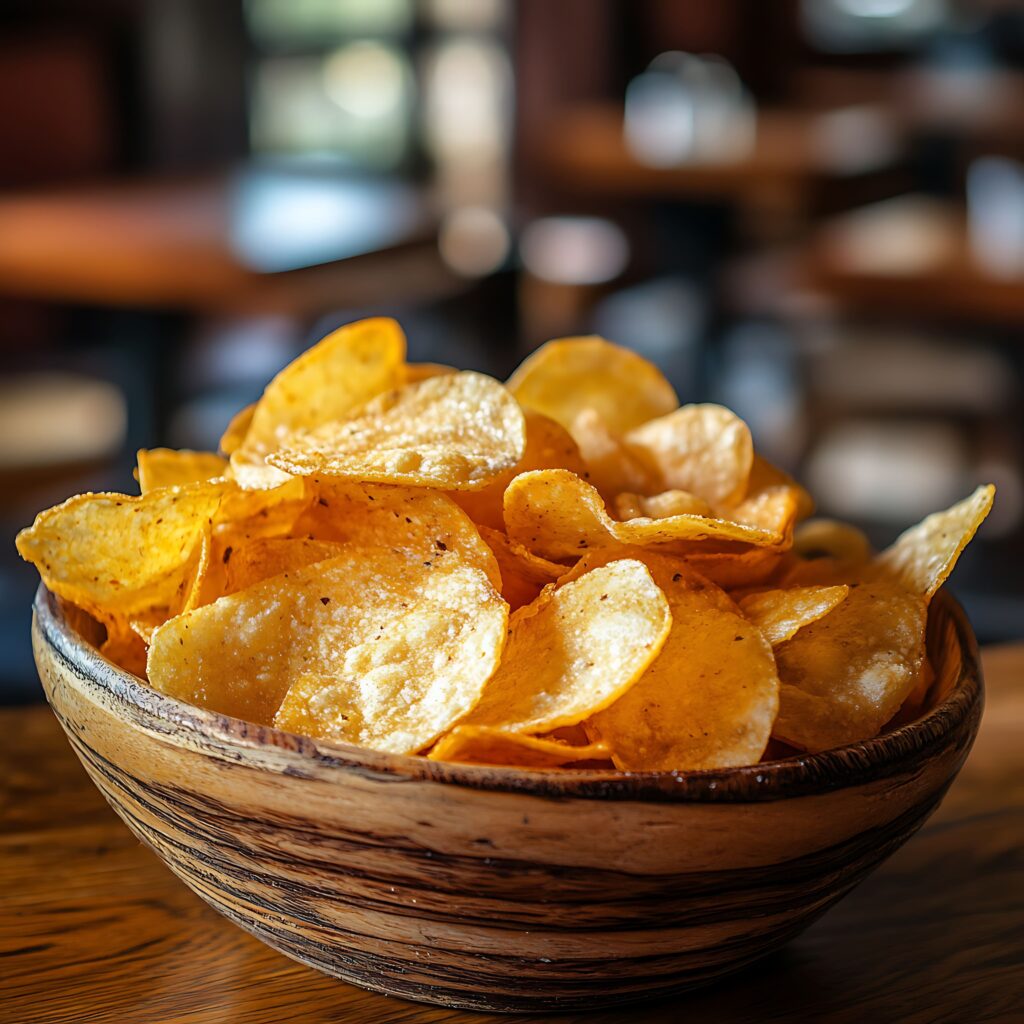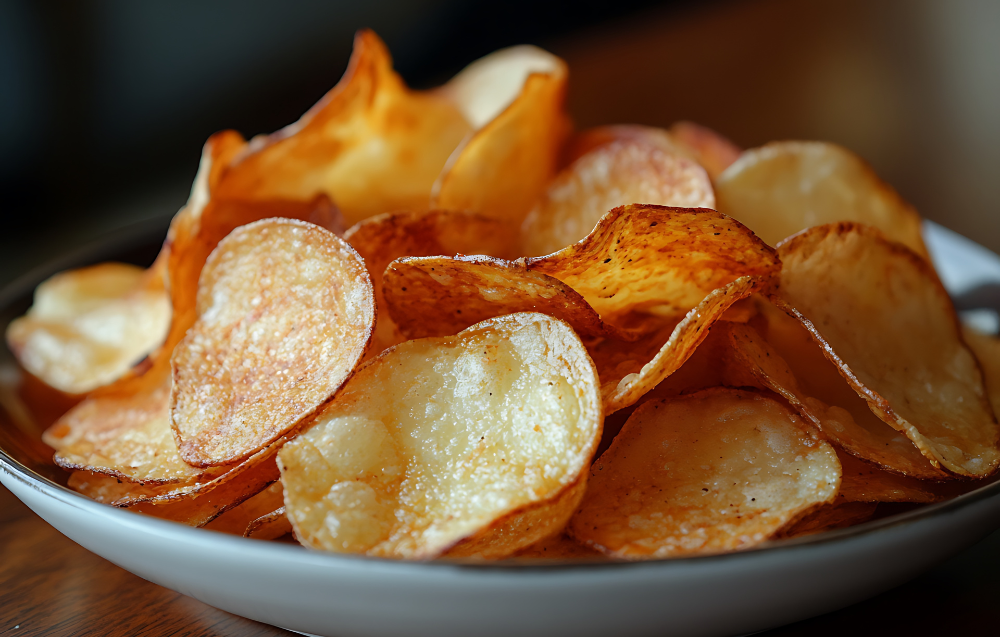Who doesn’t love a good snack with a fiery kick? Whether you’re a spice enthusiast or someone just looking to experiment, adding heat to your favorite chips is a game-changer. This article is your ultimate guide to making any chip spicy, exploring everything from the best spices to use, methods for applying them, and even solving common problems. Ready to heat things up? Let’s dive in!
Introduction to Spicing Up Chips
Chips are a universal favorite, but sometimes they lack the excitement that spice can bring. By learning how to make any chip spicy, you’re not only elevating their flavor but also turning an ordinary snack into an extraordinary treat. Why settle for plain chips when you can transform them into something bold and unforgettable?

For tips on balancing flavors, check out How to Make a Cookie Cake: A Step-by-Step Guide. Just like a good dessert, spicy snacks rely on finding the perfect balance of ingredients.
Why People Love Spicy Snacks
There’s something almost magical about spicy food. It’s not just about the taste; it’s about the experience. When you make any chip spicy, your taste buds wake up, and you might even break a sweat—that’s the thrill! Spicy snacks, like chips, combine this fiery sensation with a satisfying crunch. Plus, the endorphin rush you get from spicy food makes the whole experience even more addictive.
“Adding spice to your chips isn’t just a flavor upgrade—it’s a whole new way to snack.”
The Science Behind Spicy Flavors
Ever wondered what makes something spicy? It’s all thanks to a compound called capsaicin, found in chili peppers. Capsaicin binds to receptors in your mouth and tricks your brain into thinking it’s on fire (don’t worry, you’re not actually burning). This creates that signature heat sensation. And the best part? When you make any chip spicy, you can choose from a variety of spices to control the level of heat and customize the flavor to suit your taste.
If you’re feeling adventurous, experiment with Cajun-inspired spices. Learn more about bold flavor profiles in Cajun Shrimp Pasta Made Simple and Irresistible.
Choosing the Right Chips
Before you start spicing things up, it’s important to choose the right base for your masterpiece. Not all chips are created equal when it comes to holding and enhancing spicy flavors.
Types of Chips That Work Best
When selecting chips to make any chip spicy, consider their texture and flavor. Thick, ridged chips like kettle chips or tortilla chips work exceptionally well because they can hold spices better. Thin, flimsy chips might not be able to handle heavy spice coatings, leaving you disappointed.
For more inspiration on creating crispy, flavorful snacks, check out Spicy Chips: Crunchy Snacks Elevated.
Pairing Chips with Spices
Matching chips to the right spices is key when you want to make any chip spicy—it’s like pairing wine with food, all about balance. For instance, a salty, plain potato chip acts as a blank canvas, working beautifully with bold spice blends. Tortilla chips, on the other hand, shine when paired with smoky, chili-based spices. Don’t be afraid to experiment and discover your favorite flavor combinations!
For more ideas on pairing bold flavors, explore The Secret Ingredient in a Philly Cheesesteak You Need to Know.
“Think of your chip as the stage, and the spice as the star performer. Together, they create the ultimate show.”
Essential Spices for Adding Heat
Now, let’s get to the good stuff: spices! Adding spice doesn’t mean just sprinkling chili powder on your chips. There’s a world of flavors to explore.
Popular Spices for Spicy Chips
Here are some go-to spices to get started:
- Chili Powder: A classic that adds a rich, earthy heat.
- Cayenne Pepper: Packs a punch and takes things up a notch.
- Smoked Paprika: Adds a smoky, mild heat that’s perfect for layering flavors.
- Garlic Powder: Not hot, but it complements other spices beautifully.
- Black Pepper: A subtle heat that works well for a milder kick.
Homemade Spice Mix Ideas
Why settle for store-bought when you can make your own? Here are two easy-to-make spice mixes:
Spicy Taco Blend: Combine chili powder, smoked paprika, garlic powder, and a pinch of oregano for a zesty taco-inspired flavor.
Sweet Heat Mix: Blend cayenne pepper, paprika, and a touch of brown sugar to balance heat with sweetness.
Methods for Spicing Chips
Adding spice to chips isn’t just about sprinkling powder on top; it’s about finding the right method to evenly distribute the flavors.
Dry Spicing Techniques
Dry spicing is the simplest method to make any chip spicy and works perfectly for those looking for a quick and easy snack upgrade. All you need to do is sprinkle your spice mix directly onto the chips. However, to ensure the spices stick and distribute evenly, follow these simple steps:
- Lightly mist the chips with a neutral oil spray or a squeeze of lime juice. This creates a tacky surface for the spices to adhere to.
- Add the spice blend into a large resealable bag, toss in the chips, and shake vigorously.
- For a more intense flavor, spread the spiced chips on a baking sheet and bake at 350°F for 5-10 minutes to allow the spices to set.
This method is ideal for those using thicker chips like kettle chips or tortilla chips. For tips on safely handling chili powders during preparation, check out Tips for Handling Spicy Ingredients Safely While Cooking.
Using Liquid or Paste Coatings
If you’re looking to make any chip spicy with a bolder flavor, try using a liquid or paste coating. Simply mix your spices with a small amount of oil or lime juice, then toss the chips in the mixture to ensure even coverage. Spread the coated chips out on a baking sheet and let them dry for a few minutes to lock in the flavor.
Baked or Fried for Extra Zing?
Want to take it up a notch? Try baking or frying your spiced chips. This not only intensifies the flavor but also ensures the spice adheres perfectly to the chips. Just spread them out on a tray and bake at 350°F for 5-10 minutes, or flash fry them for a few seconds.
Want to know why capsaicin gives you that fiery sensation? Learn how capsaicin creates the fiery sensation in spicy foods to understand the science behind the heat.
Common Problems and Solutions
As exciting as spicing up chips can be, things don’t always go smoothly. From uneven spice distribution to chips that lose their crunch, there are challenges. But don’t worry, we’ve got you covered with simple solutions to common problems.
Chips Not Absorbing Spices
One of the most common issues when you try to make any chip spicy is that the spices don’t stick to the chips, leaving your snack bland and underwhelming. Why does this happen? Chips are often coated with oil during production, which can create a slick surface that prevents spices from adhering properly.
Solution: Lightly mist the chips with a spray of oil, lime juice, or even water before adding the spices. The added moisture helps the spices cling to the surface better. Alternatively, consider warming the chips slightly in the oven before spicing them; the warmth can help activate any residual oil on the chips for better adhesion.
For ideas on creative ways to serve your chips, explore creative snack pairings to enjoy with spicy chips.
Overpowering Spice Levels
Sometimes, the heat can get out of hand, leaving your mouth on fire instead of enjoying a flavorful snack. This happens when too much spice is used or the mix isn’t balanced.
Solution: If you’ve already over-spiced your chips, don’t panic. Toss them with a handful of plain, unspiced chips to dilute the heat. Alternatively, sprinkle a bit of powdered cheese or sugar to mellow out the spiciness.
“Balance is key—spices should enhance, not overwhelm. Treat them like seasoning, not a dare.”
Balancing Spice with Flavor
Adding heat is exciting, but when you make any chip spicy, remember that spice without flavor is like a car without wheels—it doesn’t go anywhere. Overly spicy chips can feel one-dimensional, lacking the depth and balance that make snacks truly satisfying.
Solution: Pair spicy seasonings with complementary flavors like garlic, onion, or even a touch of sweetness (like honey powder or brown sugar). Layering flavors creates complexity and makes your chips irresistible.
Creative Recipes for Spicy Chips
Ready to take your spicy chips to the next level? These creative recipes will transform your snack into a culinary masterpiece.
DIY Flavored Spicy Chips Recipes
Here are a few quick and easy recipes to spice up your chips:
1. Spicy Lime Zest Chips
- Ingredients: Chili powder, cayenne pepper, lime zest, and a spritz of lime juice.
- Method: Toss chips with lime juice and zest, then sprinkle on the spice mix. Bake at 350°F for 5 minutes to seal in the flavor.
2. Sweet and Spicy BBQ Chips
- Ingredients: Smoked paprika, brown sugar, garlic powder, and a touch of cinnamon.
- Method: Mix spices, lightly coat chips with olive oil, and toss in the blend. Bake or shake in a bag for even coating.
3. Smoky Jalapeño Ranch Chips
- Ingredients: Dry ranch seasoning, smoked paprika, and crushed jalapeño flakes.
- Method: Combine all ingredients and dust over chips. For extra flavor, mist chips with a light spray of olive oil before coating.
Unique International Spice Combinations
Why stop at traditional spice blends? Let’s explore some global flavors that will add an exotic twist to your spicy chips.
Mexican Tajín Twist
- Ingredients: Tajín seasoning, lime juice, and a pinch of chili powder.
- This blend offers a tangy, spicy, and citrusy kick perfect for tortilla chips.
Indian Masala Heat
- Ingredients: Garam masala, red chili powder, turmeric, and a dash of lemon juice.
- Pair this bold blend with plain potato chips for a unique, earthy flavor.
Korean Gochugaru Glaze
- Ingredients: Gochugaru (Korean chili flakes), sesame oil, soy sauce, and a sprinkle of sugar.
- Brush this paste onto chips and bake for a sweet, spicy, and umami-packed snack.
“Think beyond the spice aisle—sometimes the best flavors come from your travels or a little culinary curiosity.”
Spicing Chips for Specific Diets
Whether you’re vegan, gluten-free, or watching your sodium intake, there are ways to spice up your chips without compromising your dietary needs.
Vegan and Gluten-Free Spice Options
Good news! Most spices are naturally vegan and gluten-free. To keep your spicy chips diet-friendly, avoid pre-mixed seasonings that may contain hidden additives like dairy or gluten. Stick to pure spices and blend your own for complete control.
Recipe Tip: Try a blend of smoked paprika, nutritional yeast, and cayenne pepper for a cheesy, spicy flavor that’s entirely plant-based.
Low-Sodium Spicy Chip Hacks
Store-bought chips are often loaded with salt, and adding spice can sometimes make them taste even saltier. To create a low-sodium option, start with unsalted chips and use bold spices like black pepper, garlic powder, and chili flakes to make up for the missing saltiness.
Pro Tip: A squeeze of fresh lemon or lime juice can enhance flavor without adding sodium.
Storing and Preserving Spiced Chips
Now that you’ve mastered the art of making spicy chips, let’s talk about keeping them fresh and flavorful.
Keeping Chips Crunchy and Flavorful
Humidity and moisture are the enemies of chips. To keep your spicy creations crispy, store them in an airtight container or resealable bag. Adding a small packet of silica gel (like the ones you find in new shoes) can help absorb moisture and prolong freshness.
Best Storage Practices for Spicy Chips
For maximum flavor retention, store spiced chips in a cool, dark place away from direct sunlight. If you’ve used a wet spice coating, let the chips dry completely before storing to avoid sogginess.
The Cultural Appeal of Spicy Chips
Spicy chips are more than just a snack—they’re a global phenomenon. Different cultures have their own unique spin on creating spicy flavors, making these snacks a reflection of regional tastes and traditions. Let’s explore how spicy chips have captured the hearts (and taste buds) of people worldwide.
How Spicy Chips Became a Global Trend
The rise of spicy chips is rooted in the growing demand for bold, adventurous flavors. In the 1980s and 1990s, snack companies began experimenting with heat-packed varieties like jalapeño and chili-flavored chips. Today, the trend has exploded, and you can find fiery options everywhere, making it easier than ever to make any chip spicy or enjoy pre-seasoned spicy snacks right off the shelf.
Social media has also played a huge role. Challenges like the viral “One Chip Challenge” have made spicy snacks a symbol of fun, camaraderie, and even bravery. People aren’t just eating spicy chips—they’re documenting the experience and sharing it with the world.
“Spicy chips aren’t just about taste—they’re about the thrill, the challenge, and the shared laughter that comes with every fiery bite.”
Regional Variations in Spicy Chips
Every region has its own take on spicy chips, influenced by local ingredients and flavor preferences. Here are some standout examples:
- Mexico: Spicy chips are often flavored with Tajín, a blend of chili, lime, and salt. These tangy, spicy flavors pair perfectly with tortilla chips.
- India: Masala-flavored chips bring a mix of chili, turmeric, and coriander, creating a complex and aromatic heat.
- Korea: Gochujang and gochugaru are popular spice bases, adding a sweet and savory kick to chips.
- United States: From Flamin’ Hot Cheetos to ghost pepper chips, American brands focus on extreme heat and bold flavors.
Health Benefits of Spicy Chips
While chips aren’t typically considered a health food, adding spice can actually provide some surprising health perks. Let’s look at how these fiery snacks can benefit your body (in moderation, of course).
Capsaicin and Its Effects
The primary compound in spicy peppers, capsaicin, offers more than just heat. It has been studied for its potential health benefits, including:
- Boosting Metabolism: Capsaicin can temporarily increase your metabolic rate, helping you burn more calories.
- Pain Relief: Capsaicin is often used in topical creams for its ability to reduce pain by desensitizing nerve endings.
- Improving Digestion: Spicy foods can stimulate the digestive system, aiding in better nutrient absorption.
“Who knew a fiery snack could pack a punch in the health department? Capsaicin makes every bite a win for your taste buds and your body.”
Enjoying Spice in Moderation
While spicing up your snacks can be exciting and delicious, it’s essential to exercise moderation when you make any chip spicy. Excessive spice can irritate the stomach and lead to discomfort, turning an enjoyable treat into a painful experience. To fully savor your spicy chips, enjoy them in moderation and pay attention to your body’s limits.
Pro Tip: Pair spicy chips with a cooling dip like yogurt or guacamole to balance the heat and protect your digestive system.
Conclusion: Customize Your Spicy Chips
Creating spicy chips at home isn’t just about adding heat—it’s about crafting a snack that’s uniquely yours. Whether you love a mild kick or crave the intensity of ghost peppers, you have the tools and knowledge to make it happen. Experiment, explore, and don’t be afraid to mix things up.
Making Spicy Chips Your Way
Remember, there’s no one-size-fits-all recipe for spicy chips. Try different spices, methods, and even chip types until you find your perfect match. The beauty of making your own spicy chips is the freedom to tailor every detail to your liking.
Final Tips for Experimentation
Here are a few last tips to inspire your chip-making adventures:
- Try Sweet and Spicy: Add a dash of honey or maple syrup to your spice mix for a flavor contrast.
- Go Gourmet: Experiment with unique spices like saffron, truffle salt, or wasabi powder.
- Think Outside the Bag: Don’t limit yourself to potato or tortilla chips—try spicing up veggie chips, pita chips, or even popcorn.
“The only limit to your spicy chip creations is your imagination. So grab some spices, get creative, and crunch your way to snack perfection.”

